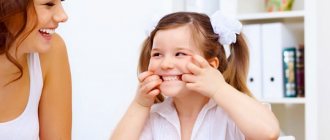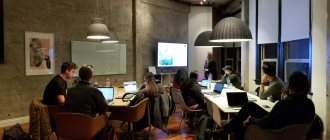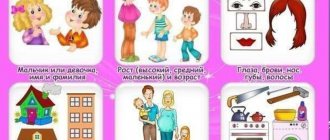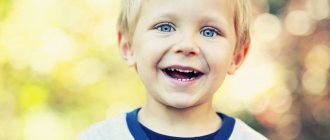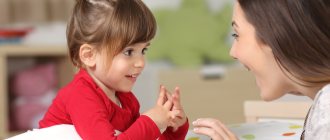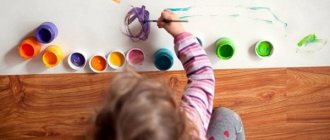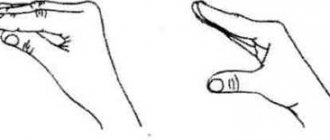Preschoolers need to receive at least minimal information about anatomy and be able to name the parts of their body. This topic is included in the educational program for children from 3 to 5 years old. Pictures for children “Parts of the human body” help teachers of kindergartens and educational centers make such lessons not theoretical, but filled with examples, visualize new knowledge. We will tell you in our article how to structure a lesson with kindergarteners, what exercises and games help them memorize new material.
Didactic preparation of classes
The formation of ideas about the human body begins from early preschool age. Educational classes using colorful pictures “Parts of the human body” are carried out in preschool educational institutions and at home with parents.
Moms and dads set goals unconsciously, they simply strive to expand the child’s range of knowledge. Kindergarten teachers formulate goals and objectives for each lesson on the topic, based on the order of the lesson, the age of the preschoolers and the novelty of the material.
Goals
Among the goals of developmental and training sessions are the following:
- To give an idea of the human body, its parts and structure through play.
- Expand the vocabulary of a preschooler.
- Develop a desire for a healthy lifestyle, caring for yourself and your health.
On a note! When planning lessons on the topic “Parts of the human body for children in pictures,” choose clear, bright pictures where all organs are shown separately. This way, kids will better remember and understand new information.
Tasks
If the topic “Parts of the Human Body” is being taught to children for the first time, then pay special attention to introducing children to vocabulary and to activating attention and interest in anatomy. In subsequent lessons, reinforce the material, promote independent activity, and use the creative potential of preschoolers. For one lesson, it is enough to select 3-4 feasible tasks.
Educational objectives for classes:
- Give an idea of the human body, parts of the body, sensory organs and their functions (done in lesson 1 on the topic).
- Learn to correctly name and show the main organs (mandatory task for 2 and subsequent lessons on the topic).
- Give an idea of the individuality and similarity of the body structure of different people.
Developmental tasks:
- Learn to correlate words and actions.
- Develop thinking, memory, imagination.
- Provoke and improve monologue and dialogic speech.
- Develop the ability to defend your opinion and use evidence in a dispute.
- Develop fine motor skills (finger gymnastics as a warm-up, creative tasks).
- Develop articulation.
Educational tasks:
- Support the desire for a healthy lifestyle.
- Cultivate a friendly attitude towards others, interest in other students in the group.
- Teach to listen to others and not be afraid to make mistakes when answering questions.
- Develop independence.
Studying body parts
I haven’t found anything on the topic (i.e. video), but there is a lot of interesting and useful information for independent study and games. If anyone finds it useful, here's something... Learning body parts with finger games
The final goal of the games below is to teach your baby to show everything on his own.
Therefore, the simpler the initial gestures are, the faster you will see results. Don’t rush things and rejoice at any, even random, movement in the right direction. The child really needs your emotions. When using these finger games, you can: * show parts of your body with your own hands; * use the baby’s hands (or feet) to touch yourself; * use the baby’s hands (or legs) to touch his body parts; * involve dad, for example, and then there will be no limit to the variety of actions. So, I offer a list of finger games that allow you to play with your baby from birth and help you study parts of the body: House Wall, wall, (touch cheeks) Ceiling, (touch forehead) Two steps, (walk fingers over lips) Ring - bell! (press on the nose) Face Where are you, my eyes? Where are you my eyes? (we take the baby’s hands and close his or our eyes with our hands) Here they are, here they are, here are my eyes. (we quickly move our hands away from our eyes and are glad that we found the eyes) Where are you, my nose? Where are you my little nose? (now we hide the nose - first it’s better yours, and then the baby’s) Here it is, here it is, here is my nose. (point to the nose) (... repeat with ears, mouth, legs...) Parts of the body Mouth, nose, head, Ears, cheeks, forehead, eyes, (we just show on ourselves or on the baby; with our own hands or the baby’s arms) Shoulders, upper arms , neck, chest (we clap the shoulders, stroke the neck and tap the chest with our fingers) Don’t forget something (we spread our arms to the sides) Hands-hands - clap-clap, (clap your hands with the baby’s hands, or you can also with your own) Legs - legs - stomp, stomp, (also with legs in a lying or sitting position) Once here and once there, (turn your head left and right; you can turn your head so that the baby can see; it is much more interesting to make a little man from your brush, and even draw on her eyes and nose) This is no, but this is yes. (gestures with the head “no” and “yes”; you can also twist the brush left and right and up and down) Our wealth Here is our nose, Here are two ears, Here is a big head, Here are a few hairs, And I will blow on them! Our baby has Heels and Knees! Here's a barrel, I'll grab it by the side, I'll tickle it for a long time! Nose, mouth, head, Ears, cheeks, forehead, eyes, Arms, shoulders, neck, chest. Don’t forget about the tummy. This is no, but this is yes. This is one, and this is two. Let's count fingers: One, two, three, four, five One, two, three, four, five Ten fingers, a pair of hands - Here is your wealth, friend! The proposed finger games are intended for infants from birth. It has already been said how such play activities help communication, and it has been suggested to start playing as early as possible. If you know more finger games that are suitable for little ones, then I will be very glad to see them in the comments (don’t forget to indicate the author or source). Elena Kovaleva www/wonder-kids.ru Games to develop a child's understanding of his body
Game - getting to know your body Play this game when your growing child begins to name the parts of his body.
Touch your ears and tell your child, “I am touching my ears. Can you touch your ears?” If he doesn't understand you right away, wait a while and repeat the question. If he quickly does what you ask, use words that he usually does not hear, such as “elbows”, “chin”, “ankles”, “back”, etc., while ensuring that he also pronounced them. If your child himself touches some part of his body, name it and touch the same part of your body yourself, imitating him. The game will be even more effective if you chant, naming each of the body parts. “Where is your head?” Touching different parts of your baby's body and naming them will help your growing baby learn more about himself. Repeat rhythmically while playing with your baby: Show me where your head is, Show me where your head is, One, two, three, Show me where your head is? Say this rhyme again and again, each time naming other parts of the child’s body. When it becomes clear to you that your baby knows at least three or four parts of his body, give him a teddy bear and ask him to touch the same parts of the bear's body. If a child starts playing this game with a bear on his own, it means he has mastered the necessary concepts. Head and shoulders Read this rhyme to your child, first touching certain parts of your own body and naming them, and then repeat all this with your baby. Head and shoulders, knees and toes, Knees and toes. Head and shoulders, knees and toes, Knees and toes. Eyes, and ears, and mouth, and nose. Head and shoulders, knees and toes, Knees and toes. Oh, how I love my baby! After playing this game for a while, see if your baby can touch the parts of the body that you mention in the rhyme. Another option is to give him a doll and see if he can find the corresponding body parts. “I have...” The more your child knows about his body, the more he will understand what he is capable of doing. Together with your baby, touch different parts of the body, saying: I have eyes to see. (Touch your eyes.) I have ears to hear. (Touch your ears.) I have legs to run. (Run in place.) I have arms to wave. (Wave your arms.) And I only have one nose. (Touch your nose.) I have a tongue to say “hello”, (Show tongue.) And rosy cheeks that you can tickle, (Touch the child’s cheeks.) And now it’s time to take a walk. (Walk around the room.) “Wiggle fingers” Sit on the floor with your child facing him. As you read the poem, wiggle your toes; stop when reading the last line. I sat as hard as I could, moving my fingers. And when I’m completely tired, “Enough!” - I told them sternly. They don’t want to calm down, They all move faster. Then we will do this - We will drive away the hair! When you say the word “drive away,” shake your index finger. Repeat the poem, naming other parts of the body instead of fingers: elbows, nose, ears and tongue. “Fingers, wake up” Play this game with your child in the morning. Take his little toes in your hand, shake them gently and sing to some pleasant tune. Toes, wake up, wake up, I love you so much! Tell me: "Good morning, Good morning, good morning." Continue singing while trying to “wake up” other parts of your baby’s body and touching them. Fingers, wake up, wake up... Shoulders, wake up, wake up... Elbows, wake up, wake up... Nose, wake up, wake up... Soon your baby will begin to move and move these parts of his body even before you touch them. “Little Man” Read the poem, accompanying it with appropriate actions. The little man ran, hurried up the hill, (Run your fingers over the child’s head.) He swallowed a piece of pie as he ran. (Touch his mouth.) His fat belly bothered him greatly. (Tap the baby on the tummy.) He held the hat with his large hand. (Raise his hand above his head.) And from behind him - what a disaster! It’s not known when the pancake stuck. (Lightly pat your baby's bottom.) "Look at the Spider" This finger game will be fun for both you and your child. Let your fingers "walk" along his arms and legs, like a spider. Look, the spider is climbing up the wall. (Slowly move your fingers up the child's hand.) Look, he goes down the web. (Quickly move your fingers down the child’s hand.) Look, the spider is running down the hill. (Move your fingers down the child’s leg.) Look, the spider is sitting at the legs. (Stop at the child’s feet.) “Look at my fingers.” Place the child on your lap and say the rhyme. Look at my hands - My fingers play, they dance. Look at my feet - My fingers are playing, they are dancing. Touch your child's fingers when you mention them; when you talk about your toes, touch them. Show your baby how to move his fingers and toes in different ways: move them, shake them. Show how to interlace your fingers. Based on materials from the site supermama.nm.ru
Progress of the lesson
A lesson in a preschool institution can be structured according to the following approximate plan:
| Lesson stage | What does it include | Duration | |
| 1. | Organizing time | We activate the children's attention to the beginning of the lesson. We greet you, seat you, create silence. | 1-2 minutes |
| 2. | Introductory part | We motivate interest in what is happening. You can ask a provocative question (Who knows how many body parts a person has? And others). Or tell an interesting story about a fairy-tale character who could not find and list all the parts of his body. Offer to help the character. | 3-4 minutes |
| 3. | Setting the task and goals of the lesson | We discuss with the children what we will do in class today, what new and interesting things we will learn (with children 3-4 years old), and create a problematic situation with children 5-6 years old. | 1-2 minutes |
| 4. | Games | Choose games aimed at memorizing the names of organs and their functions. Games can be carried out in the form of physical education. | 4 minutes |
| 5. | Warm-ups | Finger gymnastics. Performs two tasks: developing motor skills and learning the names of each finger | 3-4 minutes |
| 6. | Practical part | Let's look at the pictures. We find parts of our body from a friend, on a doll. We color, we draw. | 10 minutes |
| 7. | Reflection, summing up | We evaluate the lesson: liked it - didn’t like it. What new did you learn? Brief repetition of the main points (vocabulary). You can include riddles in reflection. | 2-3 minutes |
For children 2-3 years old, finger gymnastics replaces games and warm-ups. Can be used at the reflection stage. Learn memorable poems, show how to stretch your fingers and palms yourself.
This finger is grandpa, This finger is grandma, This finger is dad, This finger is mom, This finger is me, That’s my whole family!
Children bend their fingers on each hand separately and shake their fists intensively on the last lines.
Exercises
Use during the practical phase of the lesson. You will need pictures of “Body Parts” for children for clarity and example.
- Making up a person
Each child is given pictures of one part of the human body. The finished version is created in a group. Organize a competition for the elders to see who can assemble the person correctly the fastest.
- Where is the couple?
Mix up body parts for children in pictures. One pile should contain paired and unpaired parts. Task: to separate images based on pairing. Legs, ears, eyes, hands - in one, the rest - in the other.
- Call me kindly
I don’t have a hand, but a little hand, not a head, but a little head... It is advisable to combine lexical exercises with physical warm-up (stroking legs, arms, shaking your head, stretching your body to height). When naming a word, preschoolers look at pictures or photos for children “Parts of the human body.”
Important! Images cannot be printed in black and white. Pictures for viewing should be bright.
Games
Carry out game exercises in a group, actively. The main goal of the games: to provide new information in a memorable form. Positive emotions simplify the process of assimilation and consolidation.
- Why are they needed?
A game in the form of a question and answer. There are several answer options: detailed or yes - no. For children 3-4 years old, the following version of questions is suitable: Are ears needed to hear? YES! Do you need legs to eat? No! And so on.
For preschoolers in the middle group, ask a direct question: Why do they need legs, a head, etc. If possible, ask to justify the answer, give reasons.
- Robot
One child stands in the center of the group and completes several tasks from the children. For example, turn your head, wave your hand. The main thing is that when setting a task for a robot, preschoolers should use the names of body parts.
- Guess how much
The teacher shows a selection of photos on the topic “Sense organs pictures for children” and asks. How many ears, nostrils, tongues, eyes does a person have? Asks you to prove the correct answer by showing yourself.
Skeletal system
Digestive system
Respiratory system
Circulatory system
Puzzles
Lay out pictures or photos for children on the topic “Body Parts” on a large table. Gather the kids around him. Make riddles, the answer will be a raised card with a picture of the answer. Be sure to ask the respondent to name the correct organ and show it to yourself or a neighbor.
- No one sows them, no one plants them, they grow on their own! (Hair).
- In two holes the air wanders, then comes out, then comes in. (Nose).
- I’ll open my stable and show my friends the little white sheep. (Lips, mouth, teeth).
- If it weren't for him, no one would say anything. (Language).
- Ten brothers live in different houses. (Fingers).
- What do you need most at lunch? (Mouth).
- People have it. Animals have it. The person is smarter. (Head).
- Do you hear the water babbling? Wash your face more often... (Persons).
On a note! Riddles about parts of the human body can be presented in a presentation, followed by the correct answer in pictures for children.
Summary of a lesson in the senior group on the topic “man and parts of his body”
LESSON SUMMARY IN THE SENIOR GROUP ON THE TOPIC “MAN AND PARTS OF HIS BODY”
Goals:
1)
clarify children’s knowledge about the structure of the human body and the purpose of individual parts of the body; teach children to see signs of similarities and differences between people and express them in speech; work on enriching children's vocabulary;
2) develop speech, attention, proper breathing, hand motor skills;
3) cultivate an attentive, friendly attitude towards each other.
Dictionary:
boy, girl, man, woman, grandmother, grandfather, person, people, names of body parts (upper and lower limbs).
Equipment:
Pictures
,image of the human body; schematic representation of a person; toiletries; simple pencil.
Progress of the lesson
1.Org. moment.
There are a number of pictures on the board: girl, boy, man, woman, grandmother, grandfather.
-Who is drawn in these pictures? (girl, boy, man, woman, grandmother, grandfather)
-What can you call it in one word? ( People
)
All people are different: there are old and young, adults and children.
Look at each other carefully, how do people differ from each other?
- Look into each other's eyes. What color are they?
- Is your hair the same color?
—Are you all the same height? (invite the children to measure their height)
- But since we are so different, then why are we all called the word “PEOPLE”? What do we people have in common? How are we similar?
2.Message about the topic of the lesson.
-Who do you think we will talk about today? (person and body parts)
Working with pictures depicting the human body.
—
Look at each other carefully.
-What parts of the body does a person consist of? ( head, neck, torso, upper limbs - arms, lower limbs - legs)
—
That's right guys, we all have a head.
What's on the head? (nose, mouth, ears, eyes)
-What are the nose, mouth, ears, eyes for?
Guess the riddles.
He can be very different: kind, harmful, proud, important, long, small, hunchbacked, fat, thin,
freckled (nose)
He is always at work when we talk. And as he rests, Then we remain silent. (mouth).
3. Breathing development
Gymnastics to develop proper breathing.
We will inhale easily and smoothly, (inhale) Let us exhale protractedly. (exhale) Nose at work (inhale) Mouth at work (exhale) We all breathe well.
—What does the head “sit” on? -Why does a person need a neck?
(neck - it connects the head and torso of a person
)
—
What is the largest part of the human body called?
( torso
)
-Show me where your torso is?
- What is on the front of the body? ( chest, stomach
)
- What's behind? ( back
)
4.New material.
-What do you think the upper and lower limbs are?
-What are the hands called?
-What are the legs called?
-At the very bottom of the leg - this part of the leg (show) is called the foot.
Why do you think? ( from the word “step”
)
5.Development of motor skills.
Gymnastics for arms
A very complex man: (index finger on forehead, frown) Two eyes and two eyelids. (point to the eyes, eyelids with the index finger) And look carefully! - (index finger from the eyes to the temples) Two ears and two nostrils (point to the ears and nostrils) But there are five fingers (spread the fingers on both hands) To hold everything with them. (grabbing gesture with hands)
6.Secure the material.
Working with a human outline diagram.
Guess the riddles.
The largest part is the support for everything. And there is a neck, a back, and a stomach. Tell me, what is this? (torso)
Always combed, clean, smart - The beginning of everything. (head)
They've been racing all their lives, but they can't overtake each other. (legs, lower limbs)
Part of the body that is not afraid to do business (arms, upper limbs)
Two mothers have five sons - one name for all (hands and fingers)
Game "STOP"
The teacher shows the children two drawings. (girl and boy)
—Who do you think the artist depicted?
- Why do you think so?
-What are our boys like? (strong, brave, future men, protectors)
7. Compilation of sentences using visual material. Introduction of verbs into speech.
Using toiletries.
-What things does a person need to be clean and tidy? In the store: soap, toothbrush, toothpaste, shampoo, washcloth, comb, towel.
-Why does a person need these things? -What things do you think every person should have exclusively? -Another person cannot use these things. Why?
8.Result.
-What parts of the human body do you remember? -What does a person need to be clean and tidy?
LiveInternetLiveInternet
Tuesday, September 24, 2013 23:12 + in quote book Lesson notes “Parts of the body” Lesson “Parts of the body” Objectives: to introduce children to the parts of the human body; teach how to form plural nouns; learn to compose sentences using visual material; teach to distinguish between the right and left hand, leg, etc.; consolidate the dictionary on this topic; develop attention. Equipment: demonstration material - pictures of people, toiletries; handout - envelopes for each child with geometric shapes. Progress of the lesson. 1. Organizational moment. The teacher displays a series of pictures: girl, boy, man, woman, grandmother, grandfather. Children remember the sequence and pronounce it (the sequence of pictures changes several times). -What is the name of what is drawn in these pictures in one word? (People, person.) -Who do you think we will talk about? (About a person, about yourself.) The teacher shows a drawing of a person. — What is the name of the largest part of the human body? (Torso) The teacher shows where the chest, stomach, back are, then asks riddles: 1. For the animal - on the top of the head, and for us - below the eyes. (Ears) . What are ears for? 2. Two Yegorkas live near the hill. They live together. And they don’t pet each other. (Eyes) . 3. He can be very different: Kind, harmful, Proud, important, Long, small, hunchbacked, Long, small, hunchbacked, Thick, thin, freckled. (Nose) . -What is the nose for? A person also has a forehead, cheeks, eyebrows, eyelashes, nostrils, lips, and chin. (Children show the named parts of their faces). 2. Didactic game “One - many”. Ear -ears, neck-, eye-, hair, head, face-, nose-, mouth-... 3. Physical education minute. Girls and boys Children jump on the spot, Jumping like balls. They stomp their feet, they clap their hands. They clap, nod their heads, and quietly curtsy. squat slowly. — Guys, what were you clapping for just now? (Hands). -Show your right hand, your left. The teacher names the parts of the hand, and the children point to themselves (fingers, nails, palm, elbow, shoulder). -What did you stomp on? (with legs) 4. Similar work is being carried out. 4. Didactic game “Choose the words.” The teacher asks the children questions one by one: “What kind of eyes do you have?” (My eyes are beautiful, gray, large, etc.) - What kind of hair do you have? (My hair is thick, long, shiny, etc.) - What are your nose, mouth, ears like? (Similar work is being carried out). 5. Reading and discussion of an excerpt from K. I. Chukovsky’s poem “Moidodyr”. Oh, you ugly, oh, you dirty, unwashed pig! You are blacker than a chimney sweep, admire yourself. There's polish on your neck, There's a blot under your nose, You've got such hands that even your trousers have come off, Even your trousers, even your trousers. They ran away from you. — Guys, who do you think these poems are about? (About a slob, a dirty person.) - What should you do to be clean? (Wash your face, wash your hands, body, etc.) -Show me how to do it. Children stand one after another and imitate movements, showing how they wash themselves, wash their hands, feet and other parts of the body. -A person must be neat and clean. It is always a pleasure to communicate with such a person. To do this, you need to wash your hands, comb your hair, clean and iron your clothes, and clean your shoes every day. 6. Didactic game “What things does a person need to be clean and tidy?” Various objects are laid out on the table: toothbrush, soap, iron, washcloth, etc. Children choose any object and make up sentences. For example: A person needs a comb to comb his hair, etc. 7. Educational task - create a human figure. 8. Summary of the lesson. Children name the main parts of the human body in a “chain”.
| Categories: | Teaching is not a job, but a way of life
|
Tags:
Lesson notes “Parts of the body”
Cited 1 time
Like share
0
Like
- I liked the post
- Quoted
- 0
Saved
- Add to quote book
- 0
Save to links
Liked
0
